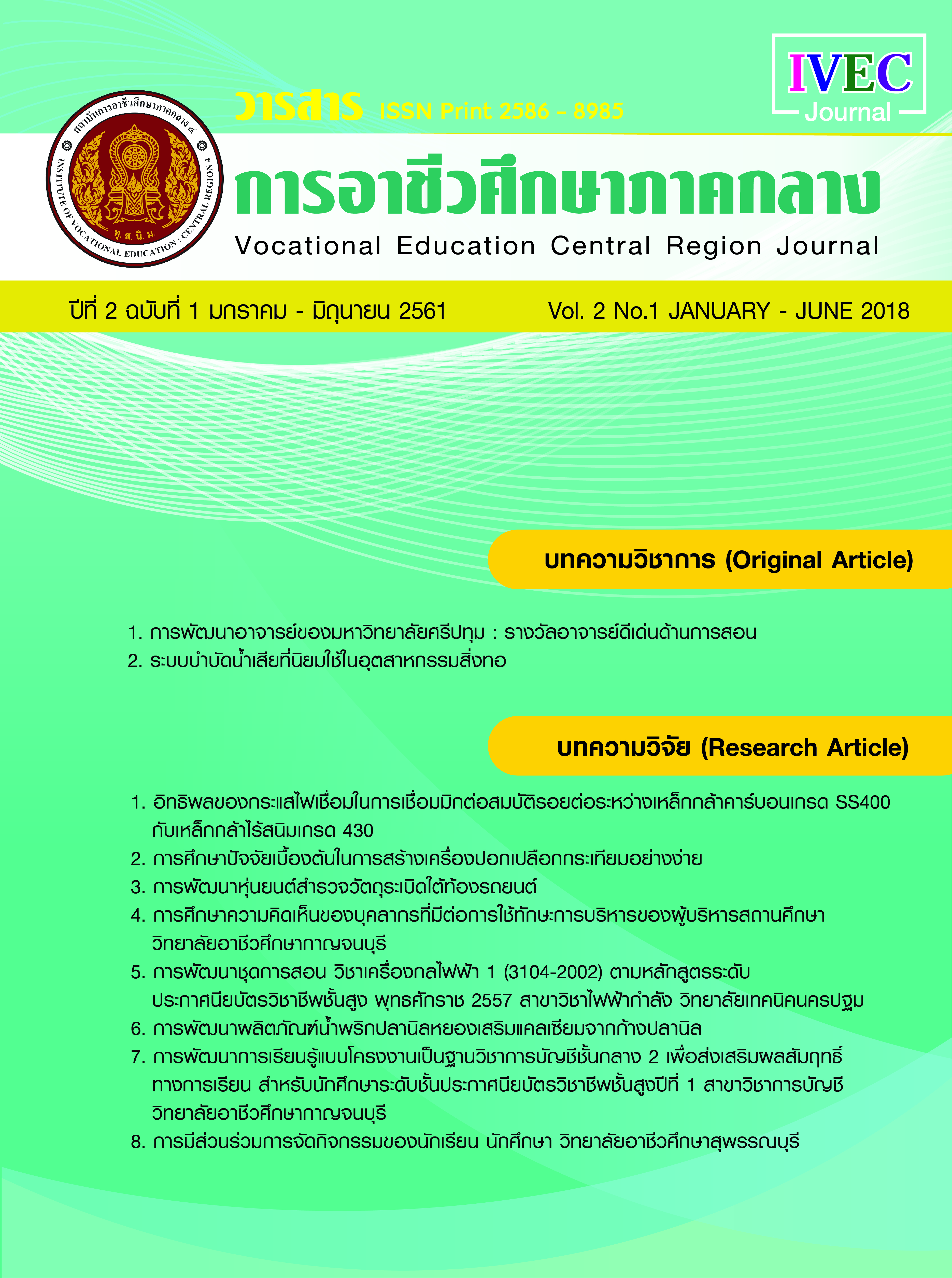Effect of Current on MIG Welding Parameters on Joint Properties of Between SS400 Carbon Steel and 430 Stainless Steel
Main Article Content
Abstract
This article aimed to study the influence of current on MIG welding on the joint property between SS400 carbon steel and 430 grade stainless steel using four welding currents were; 90, 100, 110 and 120 A
The experimental results found that every macro welding current with welding speed 400 mm/min. gas cover Ar80% + CO220% at current 110 A. A weld excellent penetration, the surface ware was a good weld and suitable for most welding. Welding with current 100 - 120 A. was stronger than SS400 steel test pieces because the lack of tensile test pieces were not missing at the weld area. However, there was a lack of hot zone (HAZ) on SS400 steel. The effect at 110 A of heat on the structure of the work resulted in a maximum tensile strength of 448 MP. From the study, it was found that the welding parameters have an effect on the melting and metal water transfer between the welding wire and the work piece by electric current helps to complete the arc. Low current affects the welding strength of the weld. Due to incomplete melting, the lack of tensile test specimens were absent at the welding edge and low tensile strength were not suitable for welding. All welding currents gave similar hardness values. It was found that the welding area gave more hardness than other areas. The HAZ hardness of the AISI 430 specimens was higher than the HAZ of the SS 400 specimen and the hardness was similar to the welding. The maximum weld hardness is 309 HV.
Article Details
|
บทความ ข้อมูล เนื้อหา รูปภาพ ฯลฯ ที่ได้รับการตีพิมพ์ในวารสาร การอาชีวศึกษาภาคกลาง ถือเป็นลิขสิทธิ์ของวารสารการอาชีวศึกษาภาคกลางหากบุคคลหรือหน่วยงานใดต้องการนำทั้งหมดหรือส่วนใดส่วนหนึ่ง ไปเผยแพร่ต่อหรือเพื่อกระทำการใด ๆ กองบรรณาธิการไม่สงวนสิทธิ์ ในการคัดลอกบทความเพื่อการศึกษาแต่ให้อ้างอิงแหล่งที่มาให้ครบถ้วน สมบูรณ์ สงวนสิทธิ์ โดย สถาบันการอาชีวศึกษาภาคกลาง 4 ที่ตั้ง 90 ถนนเทศา ตำบลพระปฐมเจดีย์ อำเภอเมือง จังหวัดนครปฐม โทรศัพท์ 034 242 856 , โทรสาร 034 242 858 ISSN : 3056-9176 (print) ISSN : 2985-2382 (online) |
References
จงกล ศรีธร. (2558). ผลกระทบของกระบวนการเชื่อมต่อสมบัติทางกลของการเชื่อมพอก ผิวแข็งเหล็กกล้าคาร์บอนด้วยทังสเตนคาร์ไบด์หลอมเหลว สาขาวิชาวิศวกรรมอุตสาหการ สำนักวิชาวิศวกรรมศาสตร์ มหาวิทยาลัยเทคโนโลยีสุรนารี.
ดํารงค์มิตร เหียนขุนทด , สุริยา ประสมทอง , สุวัฒ ภูเภา เจษฎา แก้ววิชิตร และกิตติพงษ์ กิมะพงศ์ อิทธิพลกระแสเชื่อมอาร์กโลหะแก๊สคลุมต่อความแข็งแรงกระแทกเหล็กกล้า JIS SKD 11. (ม.ป.ป.) การประชุมวิชาการแห่งชาติมหาวิทยาลัยเกษตรศาสตร์ วิทยาเขตกําแพงแสน ครั้งที่ 10. https://esd.kps.ku.ac.th/kuk-conference/img/gallery/article_10/pdf/o_eng37.pdf : หน้า 1530 – 1538
ยงยุทธ ดุลยกุล, นภิสพร มีมงคล และประภาส เหมืองจันทร์บุรี. (2551). การศึกษาโครงสร้างทางโลหะวิทยาและสมบัติทางกลของการเชื่อมเหล็กกล้าคาร์บอนด้วยกระแสเชื่อมและส่วนผสมของแก๊สคลุมที่แตกต่างกัน โดยกรรมวิธีการเชื่อมแม๊ก. งานประชุมวิชาการ IE NATEWORK 2007 ครั้งที่ 6 ณ มหาวิทยาลัยสงขลานครินทร์. 8-9 พฤษภาคม 2551. หน้า 89.
Branes, T.A. and Pashyby, I.R. (2002). Joining Techniques for Aluminum Spaceframes used in Automobiles Part I-Solid and Liquid Phase Welding. J. Materials Processing Technology. 99 (20), pp 62-71.
Brandon, D. and Kaplan, W.D. (1997). Joining Processes : An introduction. New York: John Wiley&Sons.


